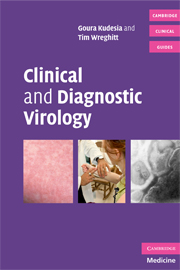Book contents
- Frontmatter
- Contents
- List of plates
- Preface
- Acknowledgements
- SECTION 1 INDIVIDUAL VIRUSES
- Introduction to virology
- 1 Adenoviruses
- 2 Arboviruses and haemorrhagic fever viruses
- 3 Cytomegalovirus (CMV)
- 4 Epstein–Barr virus (EBV)
- 5 Enteroviruses
- 6 Hepatitis A virus (HAV)
- 7 Hepatitis B and D viruses (HBV and HDV)
- 8 Hepatitis C virus (HCV)
- 9 Hepatitis E virus (HEV)
- 10 Herpes simplex virus (HSV)
- 11 Human immunodeficiency virus (HIV) and acquired immunodeficiency syndrome (AIDS)
- 12 Human herpes viruses types 6, 7 and 8 (HHV 6, 7 and 8)
- 13 Human T-cell leukaemia virus (HTLV)
- 14 Influenza viruses
- 15 Measles virus
- 16 Mumps virus
- 17 Noroviruses
- 18 Parainfluenza viruses
- 19 Papilloma and polyoma viruses
- 20 Parvovirus B19
- 21 Pox viruses
- 22 Rabies virus
- 23 Respiratory syncytial virus (RSV)
- 24 Rhinoviruses
- 25 Rotavirus
- 26 Rubella virus
- 27 SARS CoV and other coronaviruses
- 28 Varicella-zoster virus (VZV)
- SECTION 2 OTHER RELATED AGENTS
- SECTION 3 CLINICAL SYNDROMES
- SECTION 4 DIAGNOSTIC TECHNIQUES
- SECTION 5 PATIENT MANAGEMENT
- Index
- Plate section
8 - Hepatitis C virus (HCV)
Published online by Cambridge University Press: 07 December 2009
- Frontmatter
- Contents
- List of plates
- Preface
- Acknowledgements
- SECTION 1 INDIVIDUAL VIRUSES
- Introduction to virology
- 1 Adenoviruses
- 2 Arboviruses and haemorrhagic fever viruses
- 3 Cytomegalovirus (CMV)
- 4 Epstein–Barr virus (EBV)
- 5 Enteroviruses
- 6 Hepatitis A virus (HAV)
- 7 Hepatitis B and D viruses (HBV and HDV)
- 8 Hepatitis C virus (HCV)
- 9 Hepatitis E virus (HEV)
- 10 Herpes simplex virus (HSV)
- 11 Human immunodeficiency virus (HIV) and acquired immunodeficiency syndrome (AIDS)
- 12 Human herpes viruses types 6, 7 and 8 (HHV 6, 7 and 8)
- 13 Human T-cell leukaemia virus (HTLV)
- 14 Influenza viruses
- 15 Measles virus
- 16 Mumps virus
- 17 Noroviruses
- 18 Parainfluenza viruses
- 19 Papilloma and polyoma viruses
- 20 Parvovirus B19
- 21 Pox viruses
- 22 Rabies virus
- 23 Respiratory syncytial virus (RSV)
- 24 Rhinoviruses
- 25 Rotavirus
- 26 Rubella virus
- 27 SARS CoV and other coronaviruses
- 28 Varicella-zoster virus (VZV)
- SECTION 2 OTHER RELATED AGENTS
- SECTION 3 CLINICAL SYNDROMES
- SECTION 4 DIAGNOSTIC TECHNIQUES
- SECTION 5 PATIENT MANAGEMENT
- Index
- Plate section
Summary
The virus
Hepatitis C virus is a single-stranded RNA virus belonging to the family Flaviviridae, to which flaviruses such as dengue and yellow fever viruses also belong. There is one serotype but at least 6 different genotypes (1 to 6). Some of the genotypes are further divided into subtypes. For example there are two subtypes to HCV genotypes 1 and 3 (e.g. 1a, 1b and 3a, 3b).
The genotypes are important because the treatment response depends upon the infecting genotype. Furthermore, genotypes and subtypes are important epidemiological tools as some are geographically limited in their distribution. In the UK most of the infections are due to genotype 1a, 1b, 2 and 3. In Egypt genotype 4 predominates.
Epidemiology
Route of spread
As for hepatitis B, exposure to infected blood and secretions contaminated with infected blood is the main route of transmission, through the following:
Blood and blood product transfusion
A particular tragedy was the transmission of the virus to >90% of haemophiliacs through contaminated factor VIII prior to the introduction of screening of blood for HCV. An outbreak of HCV also occurred in Ireland related to a batch of contaminated immunoglobulin.
Intravenous drug use
In the UK, intravenous substance use (drug use) accounts for most of the infected cases and up to 50% of all IVDUs have evidence of HCV infection. Sharing of contaminated equipment is the main cause.
Iatrogenic (through medical treatment)
Reuse of needles, syringes and sharp instruments without proper sterilization for medical treatment in the developing countries has been responsible for the spread of the virus. Egypt has a high rate of HCV infection because of the reported reuse of needles during the national vaccination campaign to eliminate schistosomiasis (bilharzia), a parasitic infection.
[…]
- Type
- Chapter
- Information
- Clinical and Diagnostic Virology , pp. 41 - 45Publisher: Cambridge University PressPrint publication year: 2009

